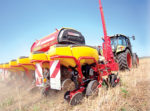Advertise Follow Us
Articles Tagged with ''clair urbain''
New technologies will help growers fine-tune their spraying applications as next-generation herbicide formulas and herbicide-resistant cropping systems hit the market.
Read More
Cut, Chop, Smooth, Mix: Vertical Tillage Seeks No-Till Role
Some no-tillers and strip-tillers say vertical-tillage tools are helping them size and incorporate residue, prepare seedbeds, reduce weed pressure and improve planting conditions without trashing no-till.
Read More
Fine-Tuning Fertility Makes Strip-Till More Profitable
Using precision technology, Paul and Mike Schweitzer continue to evolve their strip-till and fertilizer systems to slash input costs, preserve soil and water quality and achieve higher yields.
Read More
Switching Hybrids On The Fly Could Boost Corn Yields
Using equipment already available, Beck’s researchers are matching corn hybrids and populations to management zones, netting nearly 20 bushels an acre more in yields.
Read More
Promise Is Showing With Sequential Fungicide Applications
University and onfarm research is finding a one-two punch of fungicides is resulting in healthier plants and higher yields.
Read More
The Next Frontier In Seed Placement Technology
From seed tubes and seed meters to ground sensors, new equipment coming on the scene can help no-tillers achieve more consistent stands and raise planting efficiency and yields.
Read More
Manure, Crop Diversity Lock Down No-Till Profits
Koepke Farms tweaks its crop rotation, manure management and onfarm research to get the most from its no-till practices.
Read More
Putting More In The Bin, More In The Bank
A diverse cropping rotation, cover crops and onfarm research helps Ontario no-tiller/ridge-tiller Shawn McRae achieve soil and financial health.
Read More
Crop Sensors Making Their Case
These high-tech precision units can spoon-feed nitrogen where it’s needed to maximize yields — but do they pay their way?
Read More
Radishes Making No-Till Fields More Productive
Wisconsin no-tillers are finding radishes are valuable for breaking up compaction and producing nitrogen for the following year’s crop.
Read More















